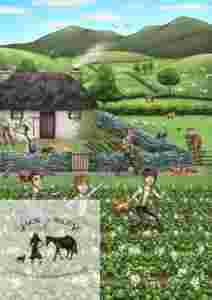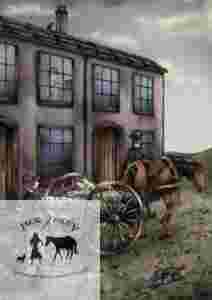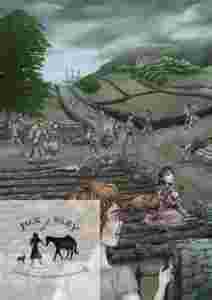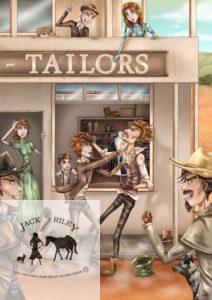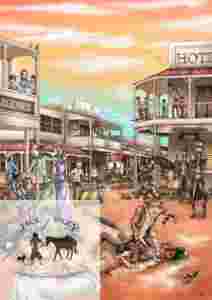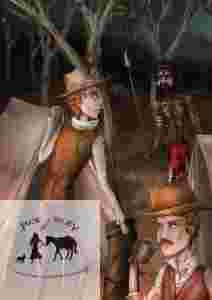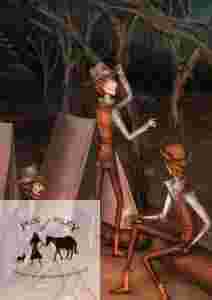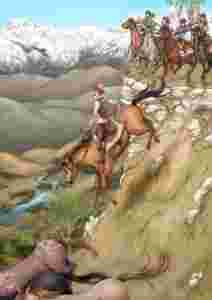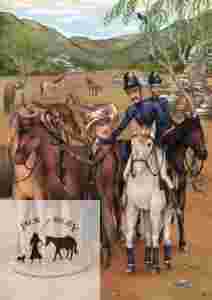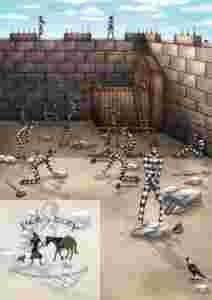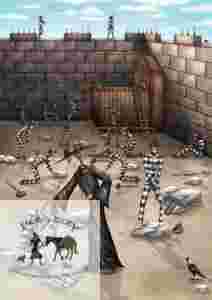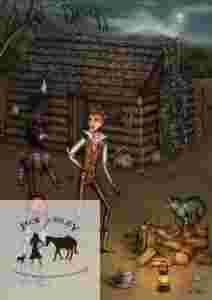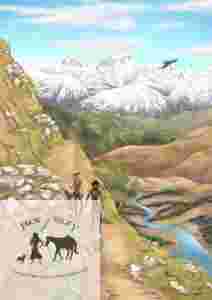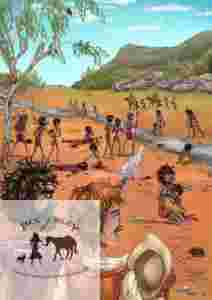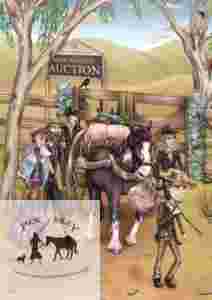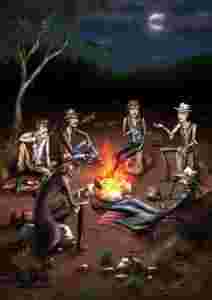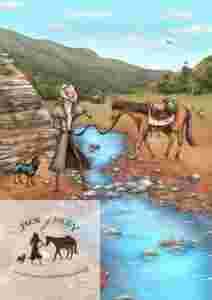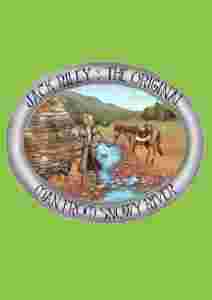The  Times
Times
24 January 1842
FOR HOBART TOWN.
![]() THE fine fast sailing ship brig SIR JOHN BYNG, John Keen, commander, is now loading for Hobart Town and will sail in a few days.
THE fine fast sailing ship brig SIR JOHN BYNG, John Keen, commander, is now loading for Hobart Town and will sail in a few days.
The Sir John Byng, having large and commodious cabins, with well-known punctuality in sailing, offers peculiar inducement for passengers.
Apply to BOYD and CO
FOR LAUNCESTON.
![]() THE fine fast-sailing Barque SOCRATES, Lewis Grant, commander, will sail to the above port on WEDNESDAY, 3 August. For freight or passage, see the Captain, onboard, or
THE fine fast-sailing Barque SOCRATES, Lewis Grant, commander, will sail to the above port on WEDNESDAY, 3 August. For freight or passage, see the Captain, onboard, or
JOHN THOM,
Thom’s Wharf.
JACK RILEY WINE COOLER BAG
The Jack Riley Edition insulated wine cooler bag celebrates the original Man from Snowy River. Carry 2 bottles of wine, beer or spirits to a BBQ, dinner, or any special occasion.
Order yours now from JackRiley.com. Be the envy of your friends with your waxed cotton wine bottle holder. It also makes a great wine gift pack.
Be quick. Order Yours now from
www.JackRiley.com
THE ANTARCTIC EXPEDITION.
Here is a reprinted extract from a letter written by Captain Ross, II.M.S. Erebus, at Hobart Town, on 7 April 1811.
Captain Ross left Auckland and will likely be very closeto his indicateddestination. We await to hear more.
Under all circumstances, it appeared to me that it would conduce more to the advancement of that branch of science, for which this expedition has been more especially sent forth, as well as for the extension of our geographical knowledge of the antarctic Regions, to endeavor to penetrate to the southward, on about the 170th degree of east longitude, by which the isodynamic oval and the point exactly between the two foci of greater magnetic intensity might be passed over, and J determined, and directly between the tracks of the Russian navigator, Bellingshausen, and our own Capt. James Cook, and after entering the Antarctic circle, to steer south-westerly towards the Pole, rather than at- tempt to approach it directly from the north, on the unsuccessful footsteps of ‘my predecessors.
Accordingly, on leaving the Auckland Islands, on 12 December, we proceeded to the southward, touching for a few days at Campbell Island, for magnetic purposes, and after passing many icebergs to the southward of 63° latitude, we made the pack-edge and entered the Antarctic circle on 1 January 1841.
This pack presented none of those formidable characters which I had been led to expect from the accounts of the Americans and French, but the circumstances wore sufficiently unfavorable to deter me from entering it at this time, and a gale from the northward
interrupted our operations for three or four days. On the morning of 11 January, when in latitude 70°41′ S and longitude 172° 36′, the land was discovered at a distance, as it afterward proved, of nearly a hundred miles, directly in the course, we were steering, and therefore directly between the Pole and us.
Although this circumstance was viewed at ‘ the time with considerable regret, as being likely to defeat one of the most important objects of the expedition, yet it restored to England the honour of the discovery of the southernmost known land, which had been nobly won, and for more than twenty years possessed by Russia.
Continuing our course towards this land for many hours, we seemed scarcely to approach it, it rose in lofty mountainous peaks of from 9 to 12,000 feet in height, perfectly covered with eternal snow; the glaciers that descended from the mountain summit projected many miles into the ocean and presented a perpendicular face of lofty cliffs. As we neared the land, some exposed patches of rock appeared; and steering towards a small bay for the purpose of effecting a landing, we found the shore so thickly lined for some miles with bergs and pack ice, and with a heavy swell dashing against it, we were obliged to abandon our purpose, and steer towards a more promising looking point to the south, of which we observed several small islands; and on the morning of the I2th, I landed, accompanied by Commander Crozier and a number of the officers of each ship, and took possession of the country in the name of Her Most Gracious Majesty Queen Victoria.
The island on which we landed is composed wholly of igneous rocks, numerous specimens of which, with other embedded minerals, were procured: it is in latitude 71° 56′ S., and longitude 171° 7′ E.
Observing that the east coast of the mainland trended to the southward, whilst the north shore took a north-westerly direction, I was led to hope that by penetrating to the south as far as practicable, it might be possible to pass beyond the Magnetic Pole, which our combined observations placed in 76° nearly; and thence, by steering westward, complete its circumnavigation. We accordingly pursued our course along with this magnificent land, and on the 23 January, we reached 7*° 15′ S., the highest southern latitude that had ever been attained by any preceding navigators, and that by
our own countryman, Captain J. Weddell.
It was still steering southward, early the next morning, a mountain of 12,400 feet above the level of the sea was seen emitting flame and smoke in splendid profusion.
This magnificent volcano received the name of Mount Erebus. It is in latitude 77° 32′ S” and longitude 167° 0’ E. An extinct crater to the eastward
of Mount Erebus, of somewhat less elevation, was called Mount Terror. The mainland preserved its southerly trending, and we continued to follow it unlit, in the afternoon, when close in with the land, our further progress in that direction was prevented by a harrier of ice, stretching away from a projecting cape of the coast, directly to the E. S. E.
This extraordinary barrier presented a perpendicular face of at least 150 feet, rising, of course, far above the mast-heads of our ships, and completely concealing from our view everything beyond it, except only the tops of n range of very lofty mountains, in an SSE direction, and in latitude 70° south.
Pursuing the examination of this splendid barrier to the eastward, we reached the latitude of 78° 4′ S., the highest we were tit any time able “to attain, on the 2 February; and having, on the 9th, traced its continuity to the longitude of 191° 23′ in latitude 78° S., a distance of more than 300 miles, our further progress was prevented by a heavy pack pressed closely against the barrier; and the narrow lane of water, by which we had penetrated thus far, become so completely covered by rapidly forming ice, that nothing hut the strong breeze with which we wore favored us to retrace our steps. When at a distance of less than a half-mile from its lofty icy cliffs, we had soundings with 318 fathoms on a bed of soft blue mud.
With a temperature of 20° below the freezing point, we found the ice to form so rapidly on the surface that any further examination of the barrier in so extremely severe a period of the season being impracticable, we stood away to the westward for the purpose making another attempt to approach the Magnetic Pole, and again reached its latitude 76° S., on 15 February, and although we found that much of the heavy ice had drifted away since our former attempt, and its place, in a great measure, supplied by recent ice, yet, we made some way through it, and got a few miles nearer to that Pole than we had before been able to accomplish, when a heavy pack again frustrated all our efforts, completely filling the space of fifteen or sixteen miles between us and the shore. We were this time in latitude 76° 12′ S., and longitude 164°, the dip being 88° 40′, and variation 109° 24′ E. We were, of course, 100 miles from the Magnetic Pole.Had it been possible to have approached any part of this coast, and to have found a place of security for the ships, we might have travelled this short distance over the land, but this proved to be utterly impracticable; and although our hopes of complete attainment have not been realized, it is some satisfaction- to feel assured, that we have approached the magnetic Pole more nearly by some hundreds of miles
then any of our predecessors, and from the multitude of observations that have been made in both ships, and in so many different directions from it, its position can be determined with nearly as much accuracy as if we had actually reached the spot itself.
It had ever been an object of anxious desire with us to find a harbour for the ships, so us to enable us to make simultaneous observations with the numerous observations that would be at work du the important term-day of 28 February, as well for other scientific purposes, but every part of the coast where indentations appeared, and where harbours on other shores usually occur, we found so perfectly filled with perennial ko of many hundred feet in thickness, that all our endeavours to find a place of shelter for our vessels were quite unavailing.
Having now completed all that it appeared to me .possible to accomplish in so high a latitude, at so advanced a period of the season, and desirous of obtaining as much information as possible of the extent and form of the coast we had discovered, ns also to guide, in some measure, our future operations, I bore away on 18 February for the north part of this land, and which by favour of a strong southerly gale, we reached on the morning of the 21st.
For several days we continued to examine the coast to the westward, tracing the pack edge along, until on 25 February we found the land abruptly to terminate in latitude 70° 40′ S., and longitude 165° E., trending considerably to the southward of west and presenting to our view an immense space occupied by the newly-formed ice, mid so covered by recent snow, as to present the appearance of one unbroken mass, and defying every attempt to penetrate it.
The great southern land we have discovered, and whose continuity we have traced from nearly 70th to the 79th degree of latitude, I am desirous of distinguishing by the name of our Most Gracious Sovereign Queen Victoria.
The 1842 retreat from Kabul (or Massacre of Elphinstone’s Army) was the entire loss of a combined force of British and Indian troops from the British East India Company and the deaths of thousands of civilians in Afghanistan between 6-13 January 1842. The massacre, which happened during the First Anglo-Afghan War, occurred when Major General Sir William Elphinstone attempted to lead a military and civilian column of Europeans and Indians from Kabul back to the British garrison at Jalalabad more than 90 miles away. Instead, they were forced to leave because of a prising led by Akbar Khan, the son of the deposed Afghan leader, Dost Mohammad Khan.
Afghan tribes launched numerous attacks against the column as it
made slow progress through the winter snows of the Hindu Kush. In total, the India Company army lost 4,500 troops, along with 12,000 civilian workers, family members, and other camp-followers. The final stand was made just outside a village called Gandamak on 13 January.
Out of more than 16,000 people from the column commanded by Elphinstone, only one European, Assistant Surgeon William Brydon, and a few sepoys would eventually reach Jalalabad. The Afghanis subsequently released a number of British prisoners and civilian hostages. However, many Indians were not handed back and were instead sold into slavery or killed.
THE GOULBURN SUBSCRIPTION RACES.
Races will take place upon the 4th, 5th, and 7th October next.
STEWARDS.
MR. BRODIE
MR. TURNBULL
JUDGE.
W. Guise, Esq.
TREASURER.
MR. McKellar.
CLERK OF THE COURSE.
MR. MARSDEN.
(Signed) JOHN GEORGE STAFFORD, Honorary Secretary.
The Stakes and other particulars will be advertised six weeks previous to the races when the Stewards pledge themselves that good results will be given.
A Superintendent or Overseer on a Sheep or Cattle Station.
WANTED, a situation as above, or to take charge of both, by a respectable person, who has filled the above situations for the last five years in the colony, to the satisfaction of his employers, and can be well recommended by his late employers, with highly respectable personal references.
Has had considerable experience in classifying and getting up of wool in a superior manner, is well accustomed to the bush, and is capable of taking charge of a large establishment. Apply personally, or by letter, postpaid, at Mr. Cockburn’s, tobacconist, George Street, Sydney.
NOTICE, THE EBENEZER COALS
are sold by theImperial Standard Ton Weight of 2249lbs, being thirty-two bushels contained in sixteen bags to the ton, each bag weighing one hundred and a quarter weight.
Price at the Depot, Davies’ Wharf, Sussex Street-2Gs. per ton weight. Delivered north of benevolent Asylum, Old Toll Gate, and west of Wooloomooloo Creek, in quantities not less than half a ton, at 28s. per ton weight; outside the said boundary, but within the town of Sydney, in quantities not less than one ton, at 30s. per ton weight; Wooloomooloo and similar distant suburbs of Sydney, at 32s. per ton weight.
